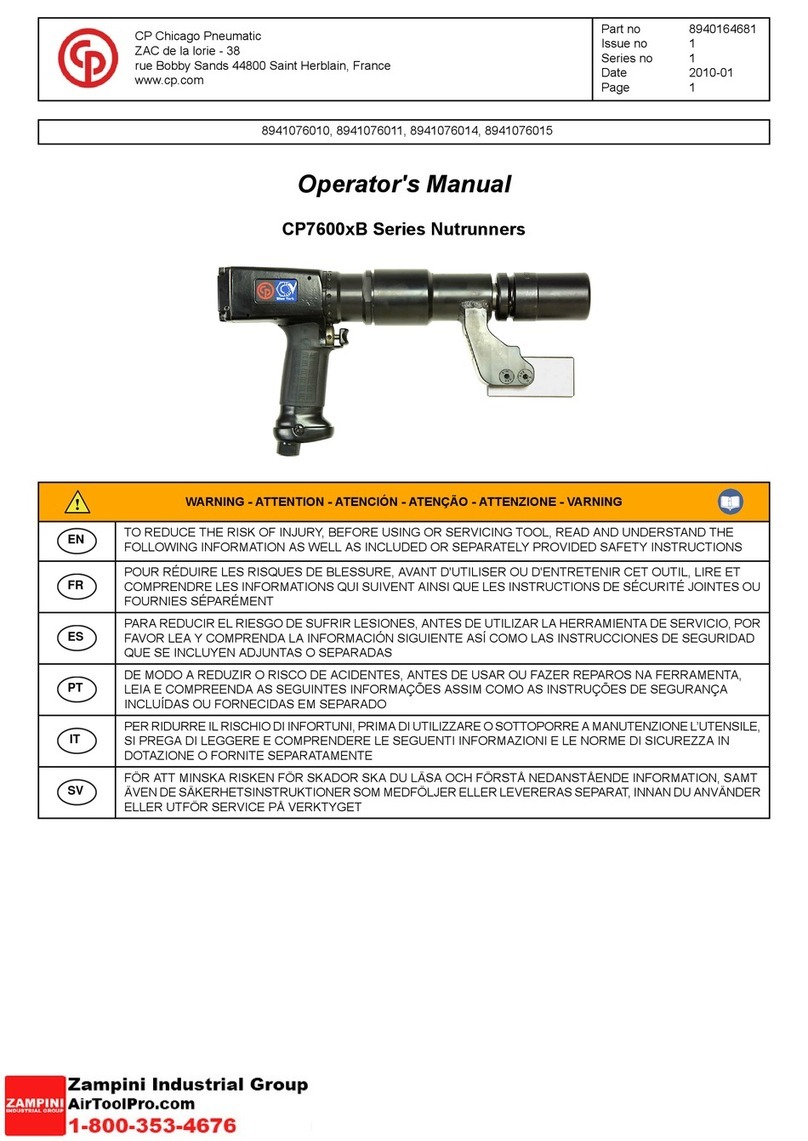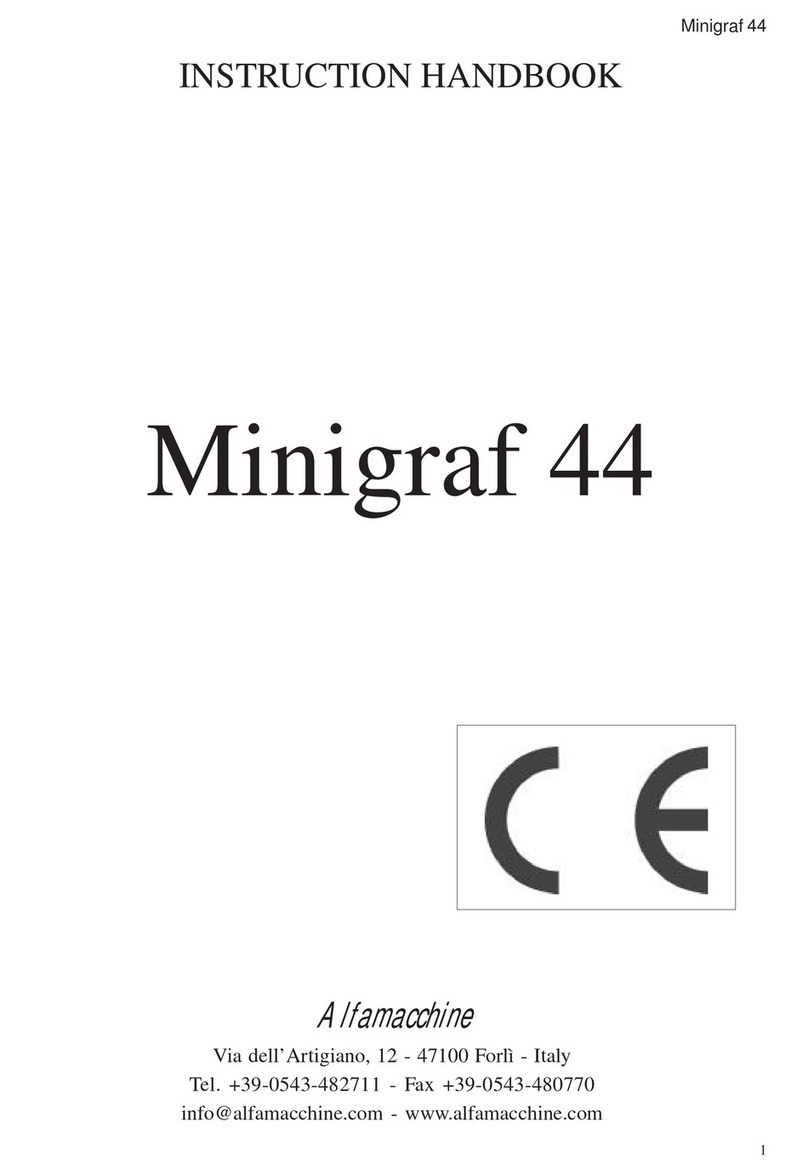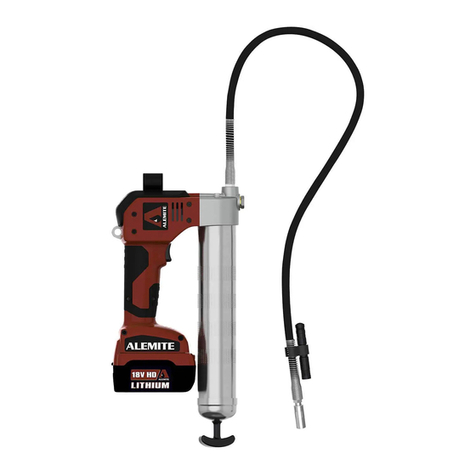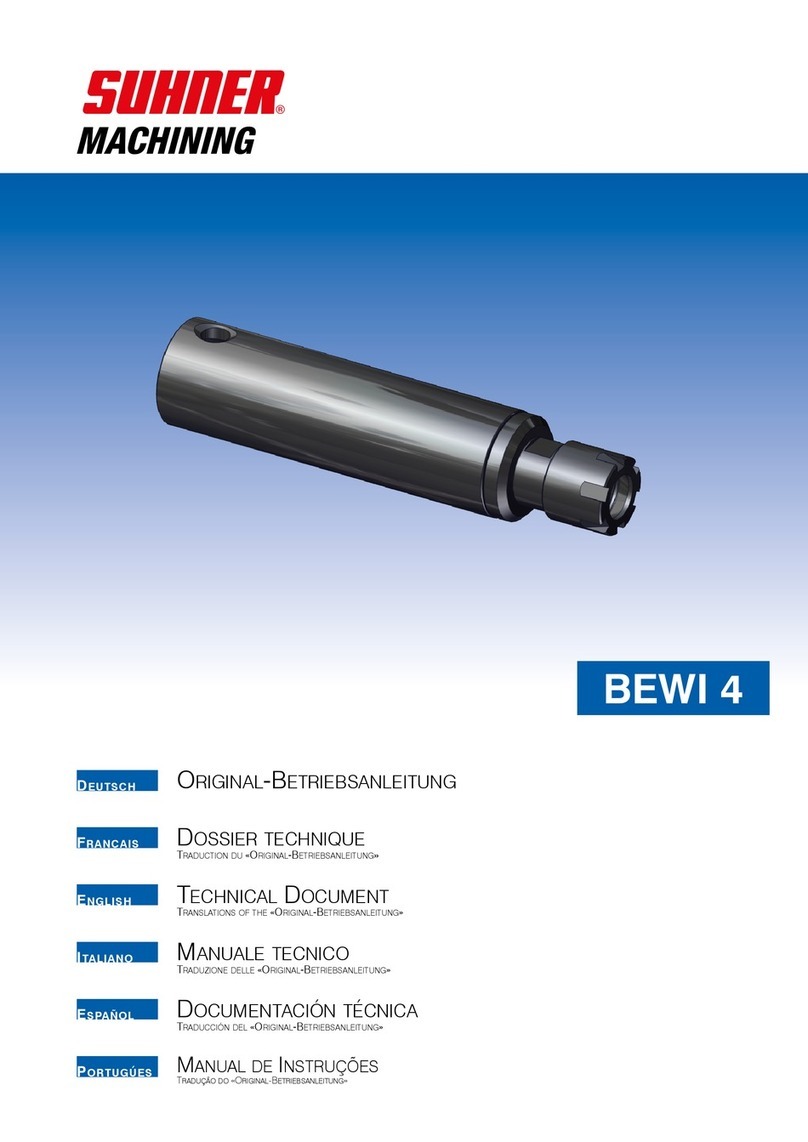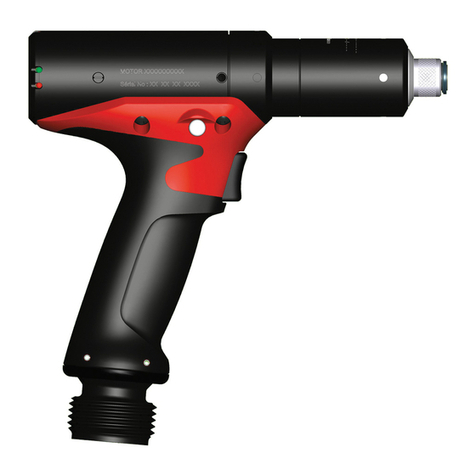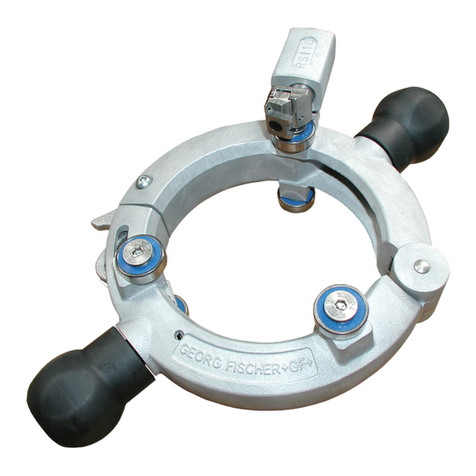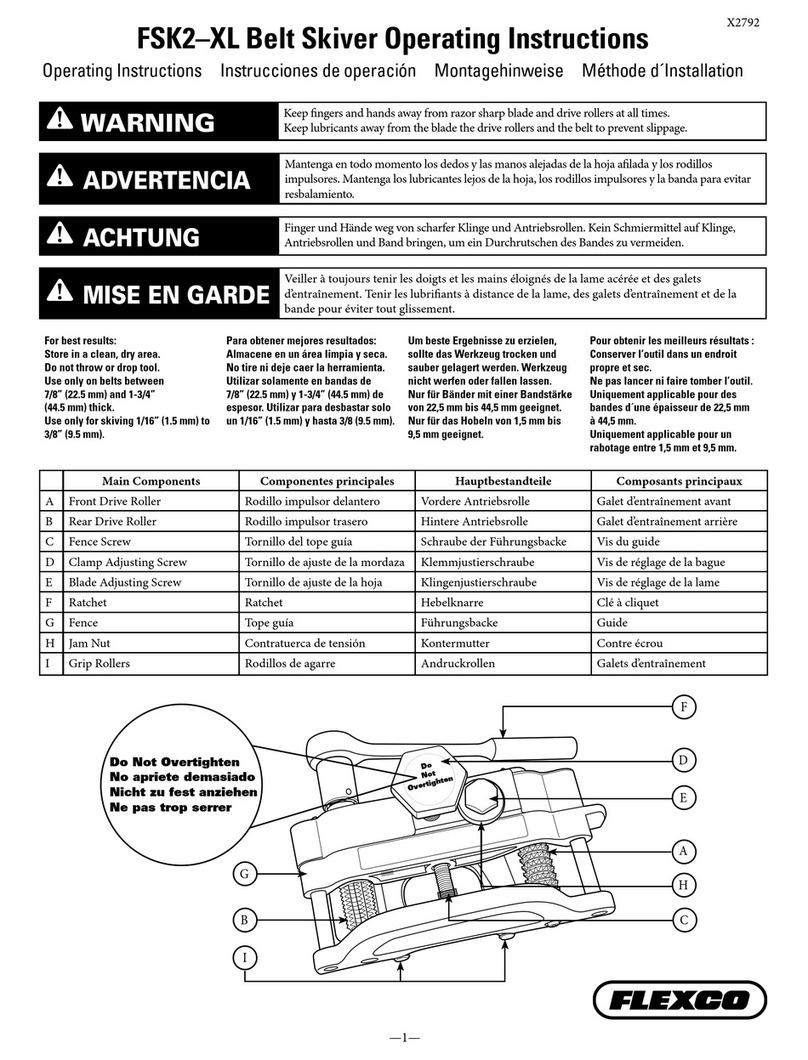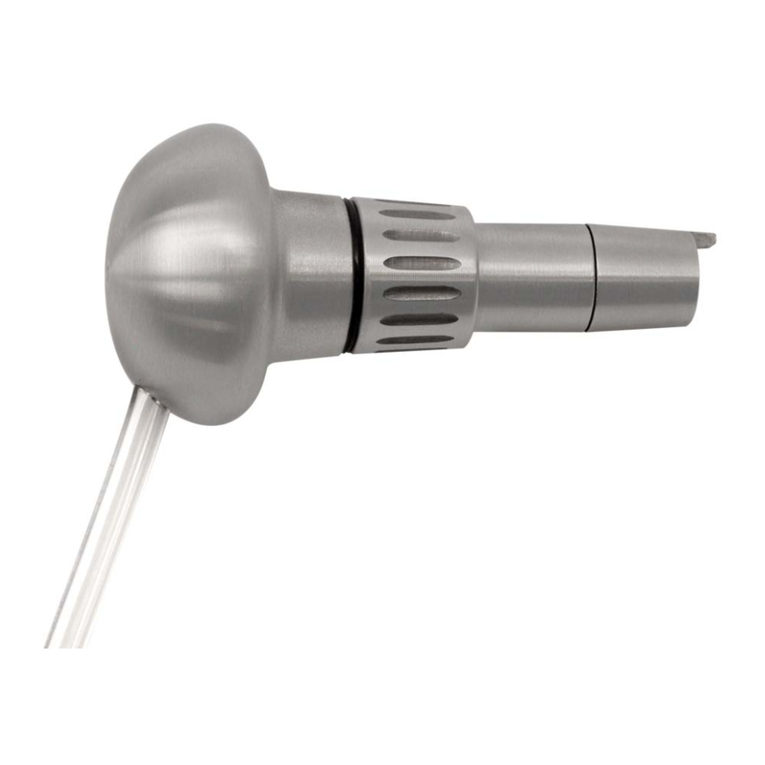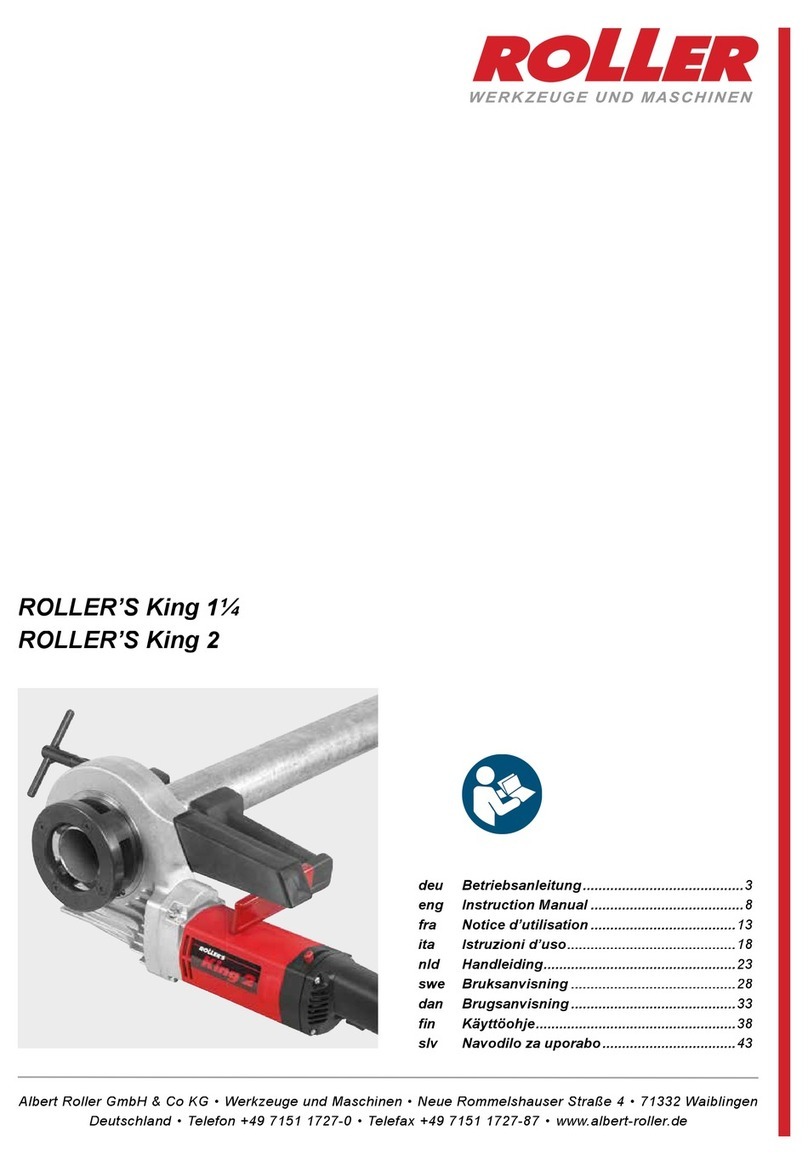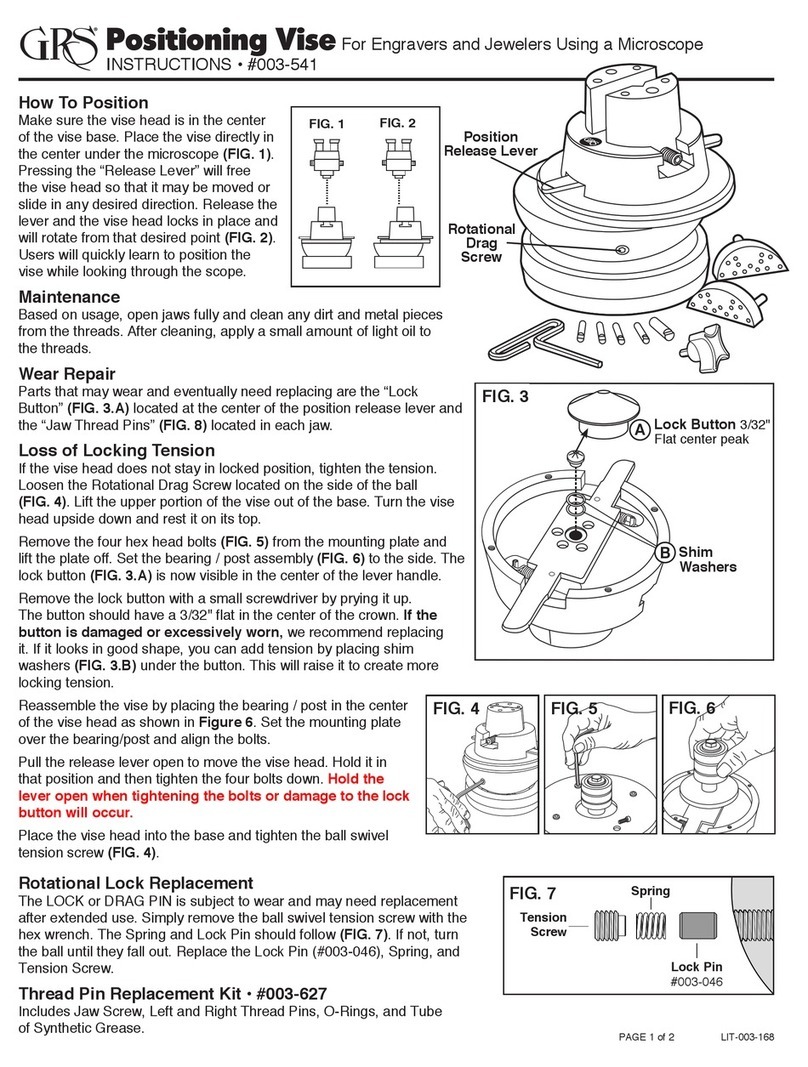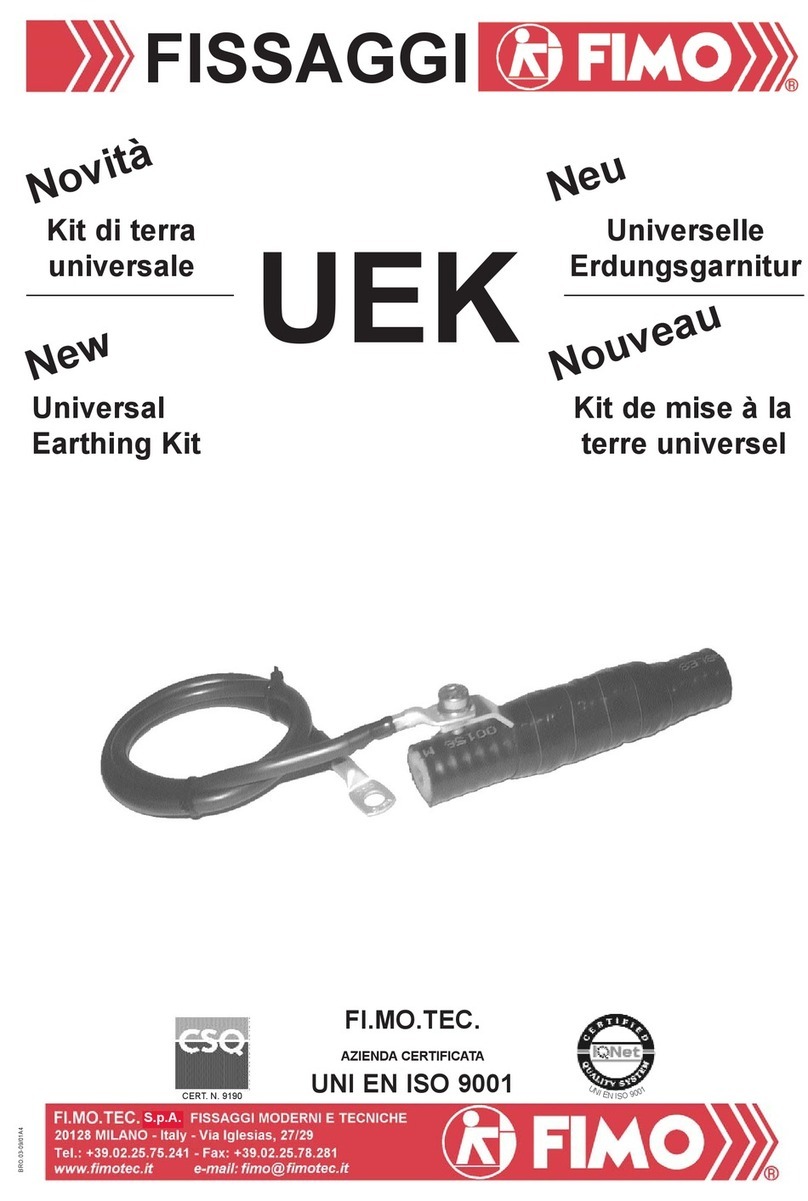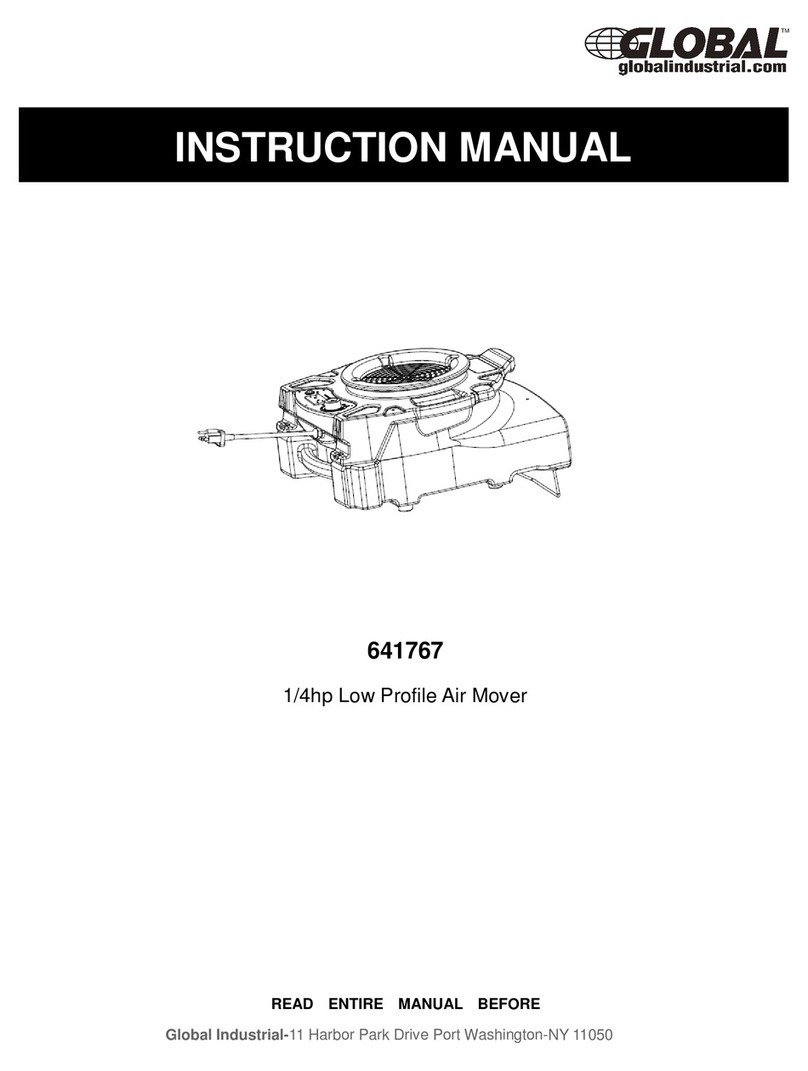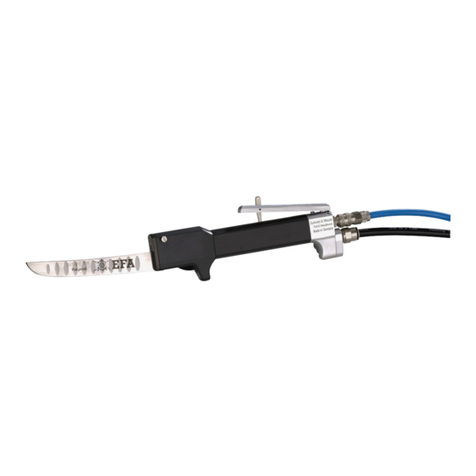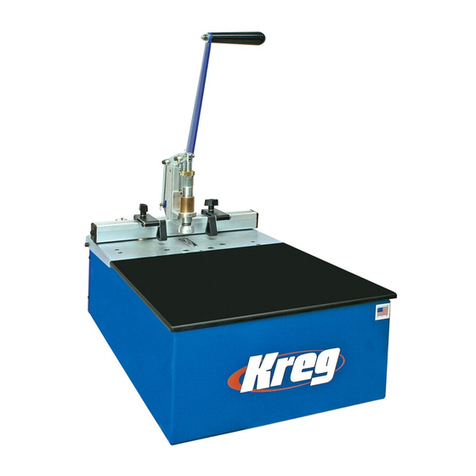CP 4123 Quick start guide

www.cp.com Chicago Pneumatic Construction Tools
Safety and Operating instructions
Chipping hammer CP 4123
CP 4125
Prescriptions de sécurité et instructions pour l’opérateur
Marteau burineur
Sicherheitsvorschriften und Bedienungsanleitung
Meißelhammer
Instrucciones de seguridad y de funcionamiento
Martillo de cincelar
Instruções de segurança e operação
Martellos raspadores
Istruzioni per la sicurezza e per l’uso
Martello scalpellatore
Veiligheidsvoorschriften en bedieningshandleiding
Breekhamer
Οδηγίες ασφάλειας και χειρισμού
Ματσακόνι
Turvallisuusohjeet ja käyttöohje
Piikkauskone-paineilmakanki
Sikkerhedsinstruktioner og betjeningsvejledning
Mejselhammer
Sikkerhetsinstrukser og bruksanvisning
Sveisehammer
Säkerhetsinstruktion och bruksanvisning
Mejselhammare

2
CP 4123, CP 4125Safety and operating instructions
9800 0606 90
2008-02
No. 9800 0606 90
©Copyright Chicago Pneumatic Construction Tools
STOCKHOLM • SWEDEN

Safety and operating instructionsContents
9800 0606 90
Contents
ENGLISH .............................................................. 4
FRANÇAIS ............................................................20
DEUTSCH ............................................................ 36
ESPAÑOL.............................................................52
PORTUGUÊS .......................................................... 68
ITALIANO ............................................................84
NEDERLANDS........................................................100
........................................................... 116
SUOMI ..............................................................132
NORSK..............................................................148
DANSK..............................................................164
SVENSKA............................................................180

ContentsSafety and Operating Instructions
4 9800 0606 90
ENGLISH
Contents
SAFETY INSTRUCTIONS 6
Safety symbols used 6
Machine and tool operating hazards 6
Explosion and fire hazard 7
Electrical/Concealed object hazards 7
Projectile hazard 7
Noise hazard 8
Silica/Dust hazard 8
Vibration hazard 8
Machine modification hazard 9
Additional safety instructions 9
Protective equipment 10
Service and maintenance 10
Inserted tools 10
Overview 11
Design and function 11
Choosing the correct pneumatic hammer 11
Main parts 11
Stamps, signs and stickers 12
Installation 12
Hoses and connections 12
Methods to prevent freezing 12
Water separator 13
Lubrication 13
Inserted tool 13
Operation14
Start and stop 14
Starting a cut 14
Operating 15
When taking a break 15
Maintenance 15
Checking for wear on the inserted tool 15
Every day 15
Three times a year(100 impact hours) 15
Assembly instructions 15
Storage16
Disposal 16
Troubleshooting16
Technical data17
Machine data 17
Noise & vibration declaration statement 18
Additional vibration information 18
Noise and vibration data 18

Safety and Operating InstructionsCP 4123, CP 4125
59800 0606 90
Introduction
Thank you for choosing Chicago Pneumatic as a supplier for tools and services.
Chicago Pneumatic is a global company offering a wide range of pneumatic and
hydraulic tools that include breakers, rock drills, chipping hammers, clay-diggers,
picks and busters, scabblers, pumps and a whole lot more.
In 2001 Chicago Pneumatic Tool Company celebrated 100 years as a pioneer
and market-leader in the pneumatic tool industry. Chicago Pneumatic has always
focused on providing powerful and reliable products that are easy to maintain and
that give good value for money. It’s a philosophy that has made us the market-
leader for air tools in the USA.
Read more at www.cp.com
About the Safety and Operating
Instructions
The aim of these instructions is to provide you with a full understanding of how
to use the pneumatic hammer in an efficient, safe way. The instructions also give
you advice and tell you how to perform regular maintenance on the pneumatic
hammer.
Before using the pneumatic hammer for the first time you must read these
instructions carefully and understand all of them.

6
CP 4123, CP 4125Safety and Operating Instructions
9800 0606 90
SAFETY INSTRUCTIONS
To reduce the risk of serious injury or death to
yourself or others, read these safety instructions
before operating the machine.
Post these safety instructions at work locations,
provide copies to employees, and make sure that
everyone reads the safety instructions before
operating or servicing the machine.
Comply with all safety regulations.
Safety symbols used
The indications Danger, Warning and Caution
have the following meanings:
Danger Indicates an imminently
hazardous situation which,
if not avoided, will result
in death or serious injury.
Warning Indicates a potentially
hazardous situation which,
if not avoided, could result
in death or serious injury.
Caution Indicates a potentially
hazardous situation which,
if not avoided, may result
in minor or moderate
injury.
Machine and tool
operating hazards
Warning
Sudden or unexpected movement of the machine
may occur during operation, which may cause
injuries. Furthermore, losing your balance or
slipping may cause injury. To reduce risks:
Make sure that you always keep a stable
position with your feet as far apart as your
shoulder width, and keeping a balanced body
weight.
Stand firmly and always hold on to the machine
with both hands.
Do not start the machine when it is lying on the
ground.
Make sure that the handle is clean and free of
grease and oil.
Warning
Unintended start of the machine may cause injury.
Keep your hands away from the start and stop
device until you are about to start work.
Warning
The inserted tool is exposed to heavy strains
when the machine is used and after a certain
amount of use the tool may break due to fatigue.
If the tool breaks, there may be sudden or strong
movements. Such sudden or strong movements
may cause serious injury.
Make sure that you always keep a stable
position with your feet as far apart as your
shoulder width, and keeping a balanced body
weight.
Keep your hands and feet away from the
inserted tool.
Check regularly for wear to the inserted tool,
and check whether there are any signs of
damage or visible cracks.
Warning
An incorrect dimension of the inserted tool’s shank
can result in the inserted tool being lost or slipping
out during operation. An inserted tool that is lost
or slips out can cause personal injury.
Before inserting the work tool, make sure that
the shank’s dimensions are the ones that should
be used in the machine.
Inserted tools without a collar may not be used.
Warning
If the cap is not fitted, the inserted tool can be
ejected with force, which can cause personal
injury.
Once the inserted tool has been mounted and
the cap fitted, the locking function must be
checked by pulling the inserted tool outwards
sharply.
Make sure that the inserted tool is fully inserted
and the cap tightened to its end position and
locked by the O-ring before the machine is
started.
Never point the inserted tool at yourself or
anyone else.

Safety and Operating InstructionsCP 4123, CP 4125
79800 0606 90
Warning
Starting the machine while changing the inserted
tool may cause personal injury.
Before changing the tool, stop the machine,
switch off the compressed air supply and bleed
the machine by activating the start and stop
device.
Warning
A compressed air hose that comes loose can lash
around and cause personal injury or death.
To reduce risks:
Check that the compressed air hose and the
connections are not damaged.
Check that all compressed air connections are
properly attached.
Never attempt to disconnect a compressed
air hose that is pressurized. First switch off the
compressed air by the compressor and then
bleed the machine by activating the start and
stop device.
Explosion and fire hazard
Warning
Breaking, hammering and working with certain
materials can cause sparks, which may ignite
explosive gases and cause explosions. Explosions
may cause serious injury or death.
To reduce such risk of explosion:
Never operate the machine in any explosive
environment.
Do not use the machine near flammable
materials, fumes or dust.
Make sure that there are no undetected sources
of gas.
Electrical/Concealed object
hazards
Warning
The machine is not electrically insulated. If the
machine comes into contact with electricity,
serious injuries or death may result.
To reduce the risk of such injury or death, never
operate the machine near any electric wire or
other source of electricity.
Make sure that there are no concealed wires or
other sources of electricity.
Warning
During breaking, concealed wires and pipes
constitute a danger that can result in serious
injury.
Before you start breaking, check the
composition of the material you are to work on.
Watch out for concealed cables and pipes e.g.
electricity, telephone, water, gas and sewage
lines etc.
If the tool seems to have hit a concealed object,
switch off the machine immediately.
Make sure that there is no danger before
continuing.
Projectile hazard
Warning
During breaking or hammering, splinters or other
particles from the worked material may become
projectiles and cause personal injury by striking
the operator or other persons.
Use approved personal protective equipment,
including impact resistant safety glasses with
side protection, to reduce the risk of being
injured by a projectile.

8
CP 4123, CP 4125Safety and Operating Instructions
9800 0606 90
Noise hazard
Warning
High sound levels may cause permanent hearing
loss.
Use hearing protection in accordance with
occupational health and safety regulations.
Silica/Dust hazard
Warning
Exposure to crystalline silica (sometimes called
‘silica dust’) as a result of breaking, hammering, or
other activities involving rock, concrete, asphalt or
other materials may cause silicosis (a serious lung
disease), silicosis-related illnesses, cancer, or death.
Silica is a major component of rock, sand and
mineral ores.
To reduce silica exposure:
Use proper engineering controls to reduce the
amount of silica in the air and the build-up of
dust on equipment and surfaces. Examples
of such controls include: exhaust ventilation,
dust collection systems and water sprays. Make
sure that controls are properly installed and
maintained.
Wear, maintain, and correctly use approved
particulate respirators when engineering
controls alone are not adequate to reduce
exposure below permissible levels.
Participate in air monitoring, medical exams,
and training programs offered by your employer
and when required by law.
Wear washable or disposable protective clothes
at the worksite; shower and change into clean
clothes before leaving the worksite to reduce
exposure of silica to yourself, other persons,
cars, homes, and other areas.
Do not eat, drink, or use tobacco products in
areas where there is dust containing crystalline
silica.
Wash your hands and face before eating,
drinking, or using tobacco products outside of
the exposure area.
Work with your employer to reduce silica
exposure at your worksite.
Warning
Some dust, fumes or other airborne material
created during use of the machine may contain
chemicals known to the State of California to cause
cancer and birth defects or other reproductive
harm. Some examples of such chemicals are:
Crystalline silica and cement and other masonry
products.
Arsenic and chromium from chemically-treated
rubber.
Lead from lead based paints.
To reduce your exposure to these chemicals,
work in a well ventilated area, and work with
approved safety equipment, such as dust masks
that are specially designed to filter out microscopic
particles.
Vibration hazard
Warning
Normal and proper use of the machine exposes
the operator to vibration. Regular and frequent
exposure to vibration may cause, contribute to,
or aggravate injury or disorders to the operator’s
fingers, hands, wrists, arms, shoulders and/or
other body parts, including debilitating and/or
permanent injuries or disorders that may develop
gradually over periods of weeks, months, or years.
Such injury or disorder may include damage to the
blood circulatory system, damage to the nervous
system, damage to joints, and possibly damage to
other body structures.
If numbness, tingling, pain, clumsiness, weakened
grip, whitening of the skin, or other symptoms
occur at any time, when operating the machine
or when not operating the machine, do not
resume operating the machine and seek medical
attention. Continued use of the machine after the
occurrence of any such symptom may increase the
risk of symptoms becoming more severe and/or
permanent.
The following may help to reduce exposure to
vibration for the operator:
Let the tool do the job. Use a minimum hand
grip consistent with proper control and safe
operation.

Safety and Operating InstructionsCP 4123, CP 4125
99800 0606 90
When the percussion mechanism is activated,
the only body contact with the machine you
should have is your hands on the handles. Avoid
any other contact, e.g. supporting any part of
the body against the machine or leaning onto
the machine trying to increase the feed force.
It is also important not to keep the trigger
engaged while extracting the tool from the
broken work surface.
Make sure that the inserted tool is well-
maintained (including sharpness, if a cutting
tool), not worn out, and of the proper size.
Inserted tools that are not well-maintained, or
that are worn out, or that are not of the proper
size result in longer time to complete a task
(and a longer period of exposure to vibration)
and may result in or contribute to higher levels
of vibration exposure.
Stop working Immediately if the machine
suddenly starts to vibrate strongly. Before
resuming the work, find and remove the cause
of the increased vibrations.
Comply with the recommended air-pressure
when operating the machine. Either higher or
lower air-pressure has the potential of resulting
in higher levels of vibration.
Do not grab, hold or touch the inserted tool
when using the machine.
Participate in health surveillance or monitoring,
medical exams, and training programs offered
by your employer and when required by law.
Note! See the “Noise & vibration declaration
statement” for the machine, including the
declared vibration values and “Additional
vibration information”. These can be found
at the end of the Safety and Operating
instructions.
Machine modification
hazard
Warning
Any machine modification not approved by
Chicago Pneumatic may result in serious injuries to
yourself or others.
The machine must not be modified
without Chicago Pneumatic's permission.
Use only original parts and accessories
approved by Chicago Pneumatic.
Additional safety
instructions
Machines and accessories must only be used for
their intended purpose.
Only qualified and trained persons may operate
or maintain the machine.
Learn how the machine is switched off in the
event of an emergency.
The maximum permissible air pressure for the
machine must not be exceeded.
Release the start and stop device immediately in
all cases of power supply interruption.
Always inspect the equipment prior to use. Do
not use the equipment if you suspect that it is
damaged.
Always use your common sense and good
judgment.
Pay attention and look at what you are doing.
Do not use the machine when you are tired
or under the influence of drugs, alcohol or
anything else that may affect your vision,
reactions or judgment.
Participate in safety and training courses.
Never strike or abuse any equipment.
Keep the machine and tools in a safe place, out
of the reach of children and locked up.
Make sure that all the attached and related
equipment is properly maintained.
Signs and stickers bearing important
information regarding personal safety and
care of the machine are supplied with every
machine. Make sure that the signs are always
legible. New signs and stickers can be ordered
from the spare parts list.
Make sure that no unauthorized personnel
trespass into the working zone.
Keep the workplace clean and free from foreign
objects.
Never point a compressed air hose at yourself or
anyone else. To avoid the risk of getting injured,
never use compressed air to blow e.g. dust, dirt
etc. from your clothes.

10
CP 4123, CP 4125Safety and Operating Instructions
9800 0606 90
Protective equipment
Always use approved protective equipment.
Operators and all other persons in the working
area must wear protective equipment, including at
a minimum:
Protective helmet
Hearing protection
Impact resistant eye protection with side
protection
Respiratory protection when appropriate
Protective gloves
Protective boots
Service and maintenance
Regular maintenance is a prerequisite for keeping
the machine safe and effective. Carefully follow the
operating instructions.
Before undertaking any maintenance or changing
the inserted tool on pneumatic machines, always
switch off the air supply and bleed the machine
by depressing the start and stop device. Then
disconnect the air hose from the machine.
Use only authorized parts. Any damage
or malfunction caused by unauthorized
parts will not be covered by Warranty or
Product Liability.
Change damaged parts immediately.
Replace damaged and worn components in
good time.
For major service to the machine, contact your
nearest authorized workshop.
When cleaning mechanical parts with solvents,
make sure to comply with current health and
safety regulations and that there is satisfactory
ventilation.
Inserted tools
Keep the tools clean and in good condition.
Regulary check the inserted tools, make sure
that they are sharp and not worn out.
Note! The machine can be destroyed if you use
incorrect inserted tools.

Safety and Operating InstructionsCP 4123, CP 4125
119800 0606 90
Overview
To reduce the risk of serious injury or
death to yourself or others, read the Safety
instructions section found on the previous
pages of this manual before operating the
machine.
Design and function
CP 4123 is a pneumatic tool designed for
rugged use in foundries, fabrication shops and
construction applications. The different stroke
versions offer the power levels necessary for a
variety of applications, from light to medium
chipping and trimming through heavy cutting.
The machine can be used both horizontally and
vertically. No other use is permitted.
CP 4125 is a pneumatic tool designed for rugged
use in foundries, shipyards, refineries, fabrication
shops and construction applications. The 22” to
4” stroke versions offer the power levels necessary
for a variety of applications from light to medium
chipping and trimming through heavy cutting.
The machine can be used both horizontally and
vertically. No other use is permitted.
Choosing the correct
pneumatic hammer
It is important to choose the correct size of
pneumatic hammer for the work to be performed.
A pneumatic hammer that is too small means that
the work will take longer.
A hammer that is too large means that there must
be frequent repositioning, which is unnecessarily
tiring for the operator.
A simple rule for choosing the correct size of
pneumatic hammer is that a normal sized piece
of broken material should be removed from the
workpiece within 5-10 seconds of operation.
If it takes less than 5 seconds a smaller
pneumatic hammer should be selected.
If it takes more than 10 seconds a larger
pneumatic hammer should be selected.
Main parts
A
B
C
D
E
F
G
H
Trigger
Handle
Piston
Cylinder
Air intake
Tool bushing
Lock coil
Retainer
A.
B.
C.
D.
E.
F.
G.
H.

12
CP 4123, CP 4125Safety and Operating Instructions
9800 0606 90
Stamps, signs and stickers
Signs and stickers with important information
about personal safety and machine care are
mounted on the machine. The signs and stickers
must always be legible. New signs and stickers can
be ordered from the spare parts list.
WARNING
To avovid injury
before using or
servicing tool, read
and understand
separately provided
safety instruction
CA 144007
PARTS CAN EJECT
FROM TOOL
DRAIN AND DISCONNECT
AIR SUPPLY FORM TOOL
BEFORE REMOVING LOCK
SPRING FROM RETAINER
P157290
A
B
The warning symbol together with the book
symbol means that the user must read the
Safety and Operating instructions before the
machine is used for the first time.
The sign informs the operator of the
following:
Before changing the tool, stop the machine,
switch off the compressed air supply and
bleed the machine by activating the start
and stop device. Use approved personal
protective equipment, including impact
resistant safety glasses with side protection,
to reduce the risk of being injured by a
projectile.
A.
B.
Installation
Hoses and connections
Connections between the compressed
air source and the machine
Select the correct dimension and length for the
compressed air hose. For hose lengths up to
100 feet (30 m), use a hose with a minimum
internal diameter of 3/4 in. (19 mm). If the hose
length is between 100 and 300 feet (30-100 m),
use a hose with a minimum internal diameter of
1 in. (25 mm).
Blow any impurities out of the compressed air
hose before connecting it to the machine.
Check that you are using the correct
recommended operating pressure, 6 bar (e).
A
B
C
D
Compressed air source
Water separator (optional)
Lubricator (optional)
Max. 10 feet (3 m) compressed air hose
between the lubricator and the machine.
Methods to prevent
freezing
Ice formation in the muffler can occur when the
ambient air temperature is 32-50 °F (0-10 °C) and
the relative humidity is high.
The machine is designed to avoid the formation
of ice in the muffler. Despite this, under extreme
conditions ice can form in the muffler.
The following actions can be taken to further
counteract the risk of ice formation:
Use an air tool oil containing antifreeze
agents.
Use a water separator.
A.
B.
C.
D.
1.
2.

Safety and Operating InstructionsCP 4123, CP 4125
139800 0606 90
Water separator
The length of the air hose between the compressor
and the water separator must be such that the
water vapor is cooled and condenses in the hose
before reaching the water separator.
The required hose length is dependant on the
ambient temperature and the relative humidity.
If the ambient temperature is below 32 °F (0 °C)
the hose must be short enough to prevent the
water from freezing before reaching the water
separator.
Lubrication
The lubricant is important for the machine’s
function and has a great impact on the service
life. In order to supply the correct volume of oil, a
lubricator should be connected to the air hose. The
use of the Chicago Pneumatic Air Line Lubricator is
recommended. To guarantee good lubrication, the
length of the air hose between the lubricator and
the pneumatic hammer should not exceed 10 feet
(3 m).
Too much lubrication may cause starting
problems, low power or uneven performance.
Recommended Lubricant: Air tool oil with a
viscosity of 100-150 SUS at 100°F (ISO VG 22–32).
It is recommended that the oil contains a rust-
inhibitor.
Inserted tool
Choosing inserted tool
A correct inserted tool is a condition for good
operation. To avoid unnecessary machine damage,
it is important to choose inserted tools with a high
quality.
Recommended inserted tools are listed in the
machine's spare parts list.
The narrow chisel should be used for demolition and
cutting work in concrete and other types of hard
material.
The moil point should only be used for creating holes in
concrete and other types of hard material.
The wide chisel should be used in soft materials e.g.
plaster and removal of tiles.
Always use a sharp tool to be able to work
effectively. A worn out tool causes increased
vibrations and the operation will take longer.
Fitting and removing the inserted tool
Warning
Starting the machine while changing the inserted
tool may cause personal injury. Before changing
the tool, stop the machine, switch off the
compressed air supply and bleed the machine by
activating the start and stop device.
Whenever fitting the inserted tool the following
instructions must be observed:
Before inserting a tool, lubricate the tool shank
with grease.
When the tool is inserted, fit the cap and check
the lock function by pulling the inserted tool
sharply outwards.

14
CP 4123, CP 4125Safety and Operating Instructions
9800 0606 90
Standard retainer, oval collar chisels,
hexagonal shank
A
Slide the chisel shank into the oval retainer
hole.
Insert the chisel shank into the tool bushing.
Rotate and lock the retainer on to the chisel.
Slide the retainer on to the cylinder.
Lock the retainer by inserting the lock coil
(A).
Standard retainer, oval collar chisels,
round shank
A
Slide the chisel shank into the oval retainer
hole.
Insert the chisel shank into the tool bushing.
Rotate and lock the chisel into the retainer.
Slide the retainer on to the cylinder.
Lock the retainer by inserting the lock coil
(A).
1.
2.
3.
4.
5.
1.
2.
3.
4.
5.
Operation
Start and stop
Start the machine by squeezing the trigger
while firmly holding the handle.
Stop the machine by releasing the trigger. The
trigger will then return to its original position.
Starting a cut
Stand steady and make sure that your feet and
hands are at a safe distance from the inserted
tool.
Press the machine against the surface of the
workpiece before starting.
Adjust the breaking distance (A) so that the
inserted tool does not get stuck.
Do not try to cut too big a bite.
Trying to loosen an inserted tool that is stuck
will expose the operator to unnecessary
vibrations.

Safety and Operating InstructionsCP 4123, CP 4125
159800 0606 90
Operating
Let the machine do the work; do not press too
hard.
Avoid working in extremely hard materials e.g.
granite and reinforcing iron (reinforcement bar)
which would cause substantial vibrations.
Any form of idling, operating without inserted
tool or operating without feed force adapted
must be avoided.
When no feed force is adapted, the start and
stop device must not be activated.
Check regularly that the machine is well
lubricated.
When taking a break
During all breaks you must put the machine
away in such a way that there is no risk of it
being unintentionally started.
In event of a longer break or when leaving
the workplace: Switch off the compressed
air supply and then bleed the machine by
activating the start and stop device.
Maintenance
Regular maintenance is a fundamental condition
for the machine to continue to be a safe and
efficient tool.
Checking for wear on the
inserted tool
Using an inserted tool with a worn out shank leads
to increased machine vibration. To avoid increased
vibrations, check the shank for wear before the
inserted tool is fitted in the machine.
Every day
Clean and inspect the machine.
Check the tool retainer for wear and function.
Conduct a general inspection for leaks and
damage.
Check that the air inlet nipple is tightened and
that the claw coupling is free from damage.
For the machine to maintain the specified
vibration values, always check the
following:
Too large a clearance between the inserted
tool’s shank and the chisel bushing will
generate increased vibrations. To avoid
exposure to excessive vibrations, check the
chisel bushing for wear every day.
Three times a year
(100 impact hours)
After each operating period of approximately
100 impact hours or 3 times a year the machine
must be dismantled and all parts be cleaned
and checked. This work must be performed by
authorized staff, trained for this task.
Assembly instructions
1
3
2
Torque: 50-60 lbf/ft (68-81 Nm),
use Loctite 243.
Torque: 35-40 lbf/ft (47-54 Nm).
Torque: 400 lbf/ft (542 Nm).
1.
2.
3.

16
CP 4123, CP 4125Safety and Operating Instructions
9800 0606 90
Storage
Make sure that the machine is properly cleaned
before storage.
Pour approximately 2 oz. (5 cl) of oil directly
into the air inlet nipple, connect the machine to
the compressed air supply and run it for a few
seconds.
Always store the machine in a dry place.
Disposal
A used machine must be treated and deposed of
in such a way that the greatest possible portion
of the material can be recycled and any negative
influence on the environment is kept as low as
possible.
Troubleshooting
If the pneumatic hammer does not start, has
low power or uneven performance, check the
following points.
Check that the inserted tool being used has the
correct shank dimension.
Check that the pneumatic hammer is receiving
the correct amount of lubricant. Too much
lubrication can cause starting problems, low
power or uneven performance.
Check that the compressed air system supplies
the machine with sufficient air pressure to
provide full power.
Check that the dimension and length
of the air hose is in accordance with the
recommendations. See “Installation”.
If there is a risk of freezing, check that the
machine's exhaust ports are not blocked.
If the machine function is still not satisfactory
after this procedure, contact an authorized
service workshop.

Safety and Operating InstructionsCP 4123, CP 4125
17
9800 0606 90
Technical data
Machine data
Model Part No. Weight
lb (kg) Length
in. (mm) Impact
freq. Hz Air Consumption
foot3/min (l/s) Shank
in. (mm)
CP 4123 2H 8900 0001 05 15 (6.9) 14¾” (375) 37 25 (12) H .580 (14.7)
CP 4123 2R 8900 0001 04 15 (6.9) 14¾” (375) 37 25 (12) R .680 (17.3)
CP 4123 3H 8900 0001 07 17 (7.5) 16¾” (425) 30 30 (14) H .580 (14.7)
CP 4123 3R 8900 0001 06 17 (7.5) 16¾” (425) 30 30 (14) R .680 (17.3)
CP 4123 4H 8900 0001 09 18 (8.1) 18⅛” (460) 24 28 (13) H .580 (14.7)
CP 4123 4R 8900 0001 08 18 (8.1) 18⅛” (460) 24 28 (13) R .680 (17.3)
CP 4125 2H 8900 0001 11 15 (6.8) 15” (380) 32 28 (13) H .580 (14.7)
CP 4125 2R 8900 0001 10 15 (6.8) 15” (380) 32 28 (13) R .680 (17.3)
CP 4125 3H 8900 0001 13 16 (7.4) 16⅜” (415) 28 32 (15) H .580 (14.7)
CP 4125 3R 8900 0001 12 16 (7.4) 16⅜” (415) 28 32 (15) R .680 (17.3)
CP 4125 4H 8900 0001 15 18 (8.0) 17½” (445) 24 28 (13) H .580 (14.7)
CP 4125 4R 8900 0001 14 18 (8.0) 17½” (445) 24 28 (13) R .680 (17.3)
All data at 6 bar (e)

18
CP 4123, CP 4125Safety and Operating Instructions
9800 0606 90
Noise & vibration declaration statement
Vibration value Aand uncertainty Bin accordance with EN ISO 8662-5. Please see table “Noise and
vibration data” for values A, B, etc.
These declared values were obtained by laboratory type testing in accordance with the stated directive
or standards and are suitable for comparison with the declared values of other tools tested in accordance
with the same directive or standards. These declared values are not adequate for use in risk assessments
and values measured in individual work places may be higher. The actual exposure values and risk of harm
experienced by an individual user are unique and depend upon the way the user works, in what material
the machine is used, as well as upon the exposure time and the physical condition of the user, and the
condition of the machine.
We, Chicago Pneumatic, cannot be held liable for the consequences of using the declared values, instead of
values reflecting the actual exposure, in an individual risk assessment in a work place situation over which
we have no control.
Additional vibration information
This tool may cause hand-arm vibration syndrome if its use is not adequately managed.
This additional vibration information may be of assistance to employers in meeting their obligations (for
example under EU Directive 2002/44/EC) to assess the risks to their workers arising from hand arm vibration
associated with the use of this tool.
The vibration emission varies greatly with task and operator technique. The declared vibration value relates
to a single axis on the D-handle and much higher vibration levels may occur at other hand positions or
measurement directions.
We recommend a programme of health surveillance to detect early symptoms that may relate to vibration
exposure, so that management procedures can be modified to help prevent significant disability.
Noise and vibration data
Vibration values
Single axis values
Declared
ISO 8662-5
A
m/s2
value
B
m/s2
spreads
CP 4123 13 6
CP 4125 13 6

Safety and Operating InstructionsCP 4123, CP 4125
199800 0606 90

SommairePrescriptions de sécurité et instructions pour
l’opérateur
20 9800 0606 90
FRANÇAIS
Sommaire
PRESCRIPTIONS DE SÉCURITÉ 22
Symboles de sécurité utilisés 22
Dangers liés à l’utilisation d’outils et de la machine 22
Danger d’incendies et d’explosions 23
Dangers liés aux objets cachés et électriques 23
Danger lié aux projections 23
Danger lié au bruit 24
Danger lié aux poussières et cristaux de silice 24
Danger lié aux vibrations 24
Danger lié aux modifications sur la machine 25
Prescriptions de sécurité supplémentaires 25
Équipements de protection individuelle 26
Entretien et maintenance 26
Outils insérés 26
VUE D’ENSEMBLE 27
Conception et fonctionnement 27
Choix du brise-béton pneumatique correct 27
Principales pièces 27
Estampilles, signes et étiquettes 28
Pose28
Flexibles et connexions 28
Mesures de prévention du gel 28
Séparateur d’eau 29
Lubrification 29
Outil inséré 29
Fonctionnement30
Marche/arrêt 30
Démarrage d’une coupe 30
Utilisation 31
Lors des pauses 31
Maintenance 31
Contrôle de l’usure de l’outil inséré 31
Chaque jour 31
Trois fois par an(100 heures d’impact) 31
Instructions d’assemblage 31
Stockage32
Destruction d’une machine usagée 32
Recherche de pannes 32
Caractéristiques techniques 33
Caractéristiques de la machine 33
Énoncé déclaratif sur les vibrations et le bruit 34
Informations supplémentaires relatives aux vibrations 34
Données relatives au bruit et aux vibrations 34
This manual suits for next models
1
Table of contents
Languages:
Other CP Tools manuals
